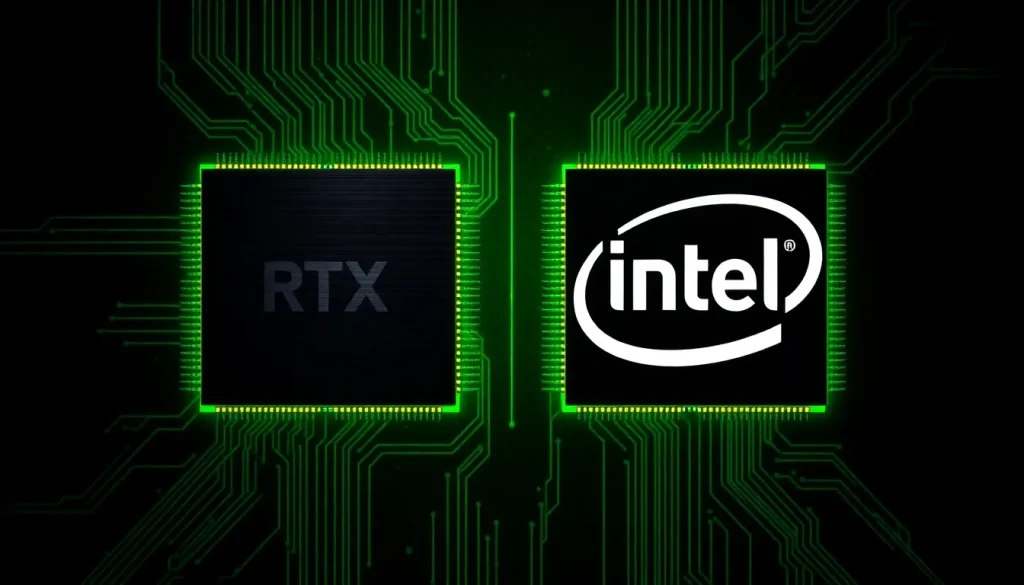NVIDIA and Intel to Develop x86 SoCs with RTX Chiplets

NVIDIA and Intel have historically operated on opposite sides of the technology spectrum, each excelling in their respective fields: processors versus graphics accelerators. While some view their relationship as a rivalry, both companies have consistently dominated their segments without heavily encroaching on each other’s territories. However, the recent partnership announcement has taken many by surprise, as it opens up new avenues for innovation and collaboration.
The official announcement reveals a strategic alliance that includes a substantial $5 billion investment from NVIDIA in Intel shares. This partnership aims to develop AI infrastructure for data centers and personal computing products. Notably, the collaboration will lead to the creation of x86 SoCs (System on Chips) featuring RTX chiplets, marking a significant shift in consumer computing.
Understanding the significance of x86 SoCs with RTX chiplets
The ambitious concept behind this partnership is to integrate Intel's expertise in x86 processors with the power of NVIDIA's RTX chiplets. Unlike traditional integrated graphics found in Intel CPUs or AMD APUs, this collaboration seeks to incorporate the processing power of dedicated NVIDIA graphics into a single SoC. This means that computers could potentially operate without a separate GPU while still delivering unprecedented graphical performance.
Current comparisons highlight that Intel has made significant strides with its Arc integrated graphics, while AMD successfully integrates high-performance RDNA graphics into its APUs. Nonetheless, a SoC incorporating RTX chiplets would provide users with NVIDIA's entire graphics ecosystem, including support for advanced technologies like DLSS and ray tracing, all within a compact and efficient design. This innovation could blur the lines between CPUs and integrated graphics, creating a new standard in computing.
Potential applications of the new SoCs
The potential applications for these new x86 SoCs are extensive and could revolutionize various computing segments:
- Mid-range laptops: These SoCs could offer affordable, high-performance laptops without the need for dedicated graphics cards.
- High-end devices: Even in premium configurations where dedicated GPUs exist, the integration of RTX chiplets ensures a baseline of graphical power and efficiency.
- Compact systems: Mini PCs and compact desktops could deliver robust gaming and creative experiences without needing additional graphics hardware.
- Conventional desktops: Mid-range desktops could provide unmatched value by integrating CPU and GPU functionalities into a single chip.
Moreover, the gaming console landscape may also be impacted. Recent speculation about a future Xbox featuring Intel CPU and NVIDIA GPU configurations may now appear more plausible, thanks to this partnership. This could redefine expectations for console performance and capabilities in the coming years.
Challenges in integrating CPU and GPU technologies
Despite the exciting possibilities, the integration of high-performance CPUs and GPUs into a single SoC presents several challenges. Key issues include:
- Energy consumption: Balancing power requirements while maintaining performance will be crucial, especially in portable formats.
- Thermal management: Ensuring sufficient heat dissipation is vital for the reliability and longevity of the devices.
- Driver compatibility: Seamless interaction with existing dedicated GPUs in high-end systems will require thorough compatibility testing.
Successfully navigating these challenges will determine whether this initiative results in a market success or simply remains a theoretical concept.
The strategic implications of the partnership
The strategic dimension of this partnership extends beyond technology innovation. For Intel, collaborating with NVIDIA provides a reliable partner that ensures continued workload for its manufacturing facilities, reinforcing the relevance of the x86 architecture at a time when ARM and RISC-V are making substantial strides. For NVIDIA, this marks its entry into the consumer CPU domain, where it has historically lacked a presence.
AMD has been the only player to consistently offer combined CPU and GPU solutions within a single chip. This alliance introduces a formidable competitor that challenges the existing balance in the market. As a result, consumers can anticipate a detailed evolution of integrated computing solutions.
Exploring the future landscape of consumer computing
Looking ahead, the implications of this collaboration are profound. As both companies combine their strengths, we may witness a transformative shift in how we understand consumer computing. The boundaries that once separated CPU and GPU functionalities could gradually diminish, giving rise to more efficient and powerful hybrid solutions.
Reflecting on this partnership, it’s evident that the landscape of personal computing is on the brink of significant change. The convergence of technologies and the breaking down of traditional silos will likely redefine not just the devices we use but also the experiences we have with them.
For those curious about the historical context, it’s fascinating to note that 20 years ago, Intel considered acquiring NVIDIA. If you’re interested in that intriguing story, you can find more details through various online resources.
In the meantime, you can watch this insightful video that discusses the collaboration between NVIDIA and Intel, which provides additional context regarding their future plans:




Leave a Reply